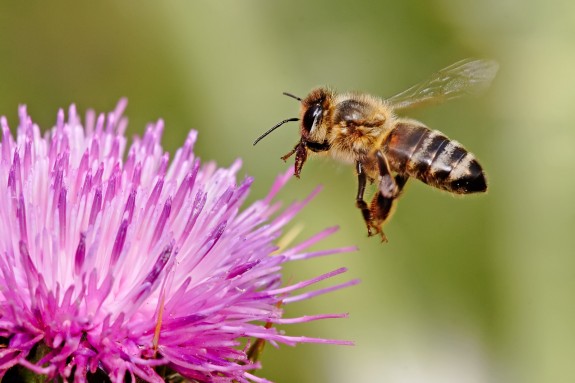Create a haven in your backyard for Bees, Butterflies and Hummingbirds with quality flower seed mixes from Botanical Interest. Enjoy a bounty of colorful flowers season-to-season and your garden will attract pollinators seeking their favorite plants. Support your local pollinators, they have vital— and essential— work to do in our environment!
Time to sow some seeds! We recommend:
- Precious Pollinators
- Save the Bees
- Hummingbird Haven
- Songbird Delight
- Bring Home the Butterflies
- Butterfly Flower Irresistible Milkweed Blend
- Butterfly Flower Common Milkweed
- Butterfly Flower Showy Milkweed
The Eastern Breeze Butterfly Collection includes:
- Butterfly Flower Milkweed
- Butterfly Flower Irresistible Milkweed Blend
- Zinnia Cut & Come Again Heirloom Seeds
- Bring Home the Butterflies
Grow Food for Our Endangered Bee Population |
|
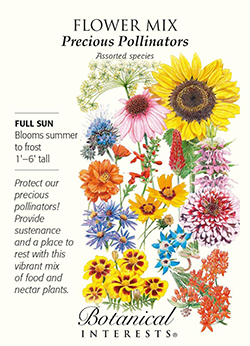 |
Precious PollinatorsPollinators help us by pollinating a third or more of the food we eat. Precious Pollinators mix provides food and nectar to a wide range of pollinators, including insects, butterflies, and moths. Colorful mix with varying heights and bloom times of annual and perennial flowers and herbs, many of which are native to North America. Annuals and perennials. |
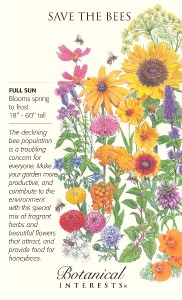 |
Save the BeesBee population has declined in recent years, and scientists aren’t sure exactly why. The variety of colorful blooms in this mix provides plentiful food for many of the over 4,000 species of bees that live in the U.S., just waiting to visit your garden! Colony collapse and die-off are serious problems for farmers and gardeners who depend on bees to pollinate many of the fruits and vegetables we eat. Bees are also important to animals and birds that feed on wild berries, nuts and seeds produced by bee-pollinated plants. Growing these flowers can help save bees, and provide you with a beautiful flower garden. Annuals, biennials and perennials. |
Create a Haven for Songbirds and Hummingbirds |
|
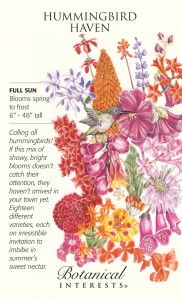 |
Hummingbird HavenYour garden haven for hummingbirds will not only attract and provide nectar for the tiny, bright creatures, but also present you with a glorious array of vivid floral colors that will last spring to fall for your enjoyment as well. Annuals, biennials and perennials. |
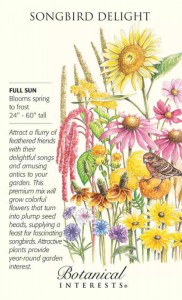 |
Songbird DelightLure colorful finches, cardinals, blue jays and nuthatches to your garden to dine on the variety of tasty seeds from the flowers that grow from this mix. A collection of annual and perennial blooming plants fill the summer garden with blue, pink, purple, white, red, orange and yellow flowers in an assortment of shapes and sizes, followed by seed heads for hungry birds. Annuals and perennials. |
Attract Butterflies to Your Backyard |
|
 |
Bring Home the ButterfliesIt’s easy to convert your garden into a private retreat for native butterflies. Butterflies use plants during each stage of their life cycle – egg, larva (caterpillar), pupa (chrysalis) and adult (butterfly). This mix includes plants for their entire life cycle, and will attract a great number and variety of native butterflies. Annuals, biennials and perennials. |
Native Milkweed |
|
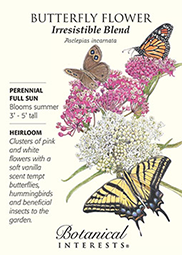 |
Butterfly Flower Irresistible Milkweed BlendAsclepias incarnata Butterflies and hummingbirds will flock to your garden to feast on the sweet nectar of this easy-to-grow native perennial. Often called Swamp Milkweed, this species grows best in moist or wet soils such as near a pond or stream, but the loosely-clumped plants will grow well in a garden with regular watering. Decorative pods are beautiful in dried arrangements. Perennial. See planting guide. |
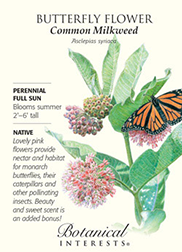 |
Butterfly Flower Common MilkweedAsclepias syriaca Observe the monarch butterfly lifecycle right in your garden! This species provides food and habitat for monarch butterflies and their caterpillars. In summer, pink to purplish or white flowers are followed by decorative seedpods that are beautiful in dried arrangements. Robust, shrub-like perennial, spreads by underground rhizomes. Drought tolerant once established. Native throughout much of the eastern United States. Perennial. See planting guide. |
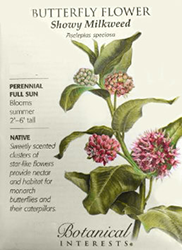 |
Butterfly Flower Showy MilkweedAsclepias speciosa Invite monarch butterflies to your garden with the stunning blooms of this robust, shrub-like perennial. Also called Greek Milkweed, this species is drought tolerant once established and grows best in well-drained soils. Plants have green to silvery-green foliage and stems that are often soft and fuzzy. In summer, pink to white flowers are followed by decorative, woolly seedpods that are beautiful in dried arrangements. Native throughout much of the western United States. Perennial. See planting guide. |
Eastern Breeze Butterfly Collection |
|
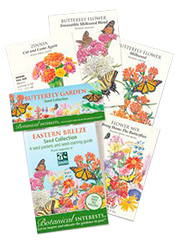
|
Eastern Breeze Butterfly CollectionAssorted Genera and species The Backyard Naturalist, along with Botanical Interests and many others, promotes the National Wildlife Federation’s Butterfly Hero Campaign to raise awareness of the monarch butterfly’s habitat loss. We believe that as home gardeners, we can help to replenish the monarch habitat by sowing milkweed and other butterfly-friendly varieties in our home, school, and community gardens. The Eastern Breeze Butterfly Collection includes two native milkweed varieties (Asclepias tuberosa and Asclepias incarnata) that serve as host plants for monarch caterpillars. Bring Home the Butterflies Flower Mix and Cut & Come Again Zinnia adds bright hues to your garden, attracting butterflies and providing nectar. Sit back and wait for the butterflies to arrive! Butterfly Flower Milkweed |
Butterfly Flower MilkweedAsclepias tuberosa We all recognize the iconic Monarch butterfly with its majestic orange and black wings. Unfortunately, the butterfly we all know and love is losing its habitat, specifically milkweed, to modern farming methods and population development. To help the Monarchs, Botanical Interests is supporting the National Wildlife Federation’s Butterfly Hero Campaign by donating seed packets to their Butterfly Garden Kit. As home gardeners, we can help to replenish the Monarch habitat by sowing milkweed and other butterfly-friendly varieties in our home, school, and community gardens. Buy some today and wait for the butterflies to arrive! Butterflies will seek out your garden when you grow this vigorous perennial, shrub-like plant; you can observe the life cycle of the Monarch butterfly! Beginning in summer, you will be treated to a profusion of fiery, red-orange flowers followed by decorative green seed pods. Drought tolerant once established. Native to much of the eastern United States. A nice addition to cut flower arrangements. Perennial. See planting guide. |
|
Zinnia Cut & Come Again Heirloom SeedsZinnia elegans pumila Cut these old-fashioned blooms for your bouquets, and flowers will “come again” producing continuously until fall frost. Long-lasting 2″ – 2½” blossoms on heat-loving plants supply endless color for your flowerbeds, containers and borders. Each individual flower lasts a very long time on the plant, and in the vase before fading. Annual. See planting guide. |
|
Planting Guide |
|||
|---|---|---|---|
| Precious Pollinators | Save the Bees | ||
|
Annuals and perennials Full sun Days to Emerge: Seed Depth: Seed Spacing: Thinning: When to sow outside: RECOMMENDED. 1 to 2 weeks before average last frost. When to start inside: Not recommended. SOWN AT THE RATE OF 25 SEEDS PER SQ. FT., THIS MIX COVERS APPROXIMATELY 25 SQ. FT. AND INCLUDES: (Percent of mix by weight) A – Annual, B – Biennial, P – Perennial Artist: Carolyn Crawford |
Annuals, biennials Full sun Days to Emerge: Seed Depth: Seed Spacing: Thinning: When to sow outside: RECOMMENDED. In cold climates, sow annual mixes in the spring, 1 to 2 weeks before the average last frost. In mild climates, sow seed during the cooler months, generally October through March. When to start inside: Not recommended. SOWN AT THE RATE OF 25 SEEDS PER SQ. FT., THIS MIX COVERS APPROXIMATELY 225 SQ. FT. AND INCLUDES: (Percent of mix by weight) A – Annual, B – Biennial, P – Perennial Artist: Carolyn Crawford |
||
Planting Guide |
Hummingbird Haven | Songbird Delight | |
|
Annuals, biennials Full sun Days to Emerge: Seed Depth: Seed Spacing: Thinning: When to sow outside: RECOMMENDED. 1 to 2 weeks before average last frost. A second option: sow half the seed 4 weeks before the average last frost (hoping the last frost is earlier than usual) and sow the second half a week or two after the average last frost (just to be safe). When to start inside: Not recommended. SOWN AT THE RATE OF 25 SEEDS PER SQ. FT., THIS MIX COVERS APPROXIMATELY 85 SQ. FT. AND INCLUDES: (Percent of mix by weight) Nasturtium (A). . 60% A-Annual, B-Biennial, P-Perennial Artist: Libby Kyer |
Annuals and perennials Full sun Days to Emerge: Seed Depth: Seed Spacing: Thinning: When to sow outside: RECOMMENDED. 1 to 2 weeks before average last frost. A second option: sow half the seed 4 weeks before the average last frost (hoping the last frost is earlier than usual) and sow the second half a week or two after the average last frost (just to be safe). When to start inside: Not recommended. Special sowing instructions: Scatter seed and rake in lightly to a depth of 1/4″. Be sure seeds are covered so that hungry birds can’t see them, and pluck them up before they have a chance to sprout. SOWN AT THE RATE OF 25 SEEDS PER SQ. FT., THIS MIX COVERS APPROXIMATELY 400 SQ. FT. AND INCLUDES: (Percent of mix by weight) Wheat (A). . 20% A-Annual, P-Perennial Artist: Marjorie Leggitt |
||
Planting Guide |
|||
| Butterfly Flower Irresistible Milkweed Blend |
Butterfly Flower Common Milkweed |
Butterfly Flower Showy Milkweed |
|
|
Perennial Days to Emerge: Seed Depth: Seed Spacing: Thinning: When to sow outside: 2 to 4 weeks before average last frost, and up to 8 weeks before first fall frost. When to start inside: 6 to 8 weeks before average last frost. Artist: Carolyn Crawford |
Perennial Full sun Days to Emerge: Seed Depth: Seed Spacing: Thinning: When to sow outside: 2 to 4 weeks before average last frost, and up to 8 weeks before first fall frost. When to start inside: 6 to 8 weeks before average last frost. Special germination instructions: Benefits greatly from stratification (see inside of packet). Artist: Carolyn Crawford |
Perennial Full sun Days to Emerge: Seed Depth: Seed Spacing: Thinning: When to sow outside: 2 to 4 weeks before average last frost, and up to 8 weeks before first fall frost. When to start inside: 6 to 8 weeks before average last frost. Special germination instructions: Benefits greatly from stratification (see inside of packet). Artist: Connie Sayas |
|
Planting Guide |
|||
| Bring Home the Butterflies | Zinnia Cut & Come Again Heirloom Seeds | Butterfly Flower Milkweed | |
|
Annuals, biennials Full sun Days to Emerge: Seed Depth: Seed Spacing: Thinning: When to sow outside: RECOMMENDED. 1 to 2 weeks before average last frost. A second option: sow half the seed 4 weeks before the average last frost (hoping the last frost is earlier than usual) and sow the second half a week or two after the average last frost (just to be safe). When to start inside: Not recommended. SOWN AT THE RATE OF 25 SEEDS PER SQ. FT., THIS MIX COVERS APPROXIMATELY 150 SQ. FT. AND INCLUDES: (Percent of mix by weight) Mexican Lupine (A) . . 30% A-Annual, B-Biennial, P-Perennial Artist: Libby Kyer |
Annual Days to Emerge: Seed Depth: Seed Spacing: Thinning: When to sow outside: 1 to 2 weeks after average last frost. When to start inside: 6 weeks before average last frost. Transplant outdoors after last frost. Zinnias do not gain from being planted early; they wait for warmer weather. Artist: Marjorie Leggitt |
Perennial Days to Emerge: Seed Depth: Seed Spacing: Thinning: When to sow outside: 2 to 4 weeks before average last frost, and up to 8 weeks before first fall frost. When to start inside: 6 to 8 weeks before average last frost. Special germination instructions: Benefits greatly from stratification (see inside of packet). Artist: Carolyn Crawford |
|
If the bee disappeared off the face of the earth, man would only have four years left to live.
― Maurice Maeterlinck, Belgian Nobel Prize Winner, The Life of the Bee

